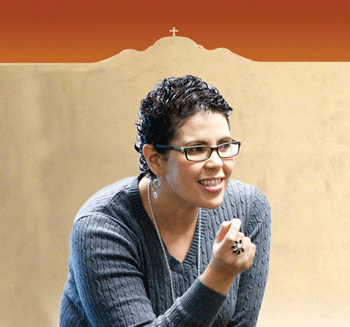 |
| Joanne Solis-Walker is director of education for Latinos and Latinas at Wesley Seminary at Indiana Wesleyan University. Most courses in her program are in Spanish and online. |
The United States is the second-largest Hispanic country in the world. “The question is this,” says Father Jorge Presmanes, director of the Institute of Hispanic/Latino Theology at Barry University in Miami Shores, Florida. “Are we going to minister to these people — or are we going to close our eyes?”
The U.S. Census Bureau estimates the U.S. Hispanic population at nearly 50 million, and Statistics Canada says that more than 300,000 Latin Americans reside in Canada. But both Protestant and Catholic Latinos are underserved by their churches, says Father Presmanes. “McDonald’s and Burger King know the importance of paying attention to this market,” he says. “But in religion, it’s an afterthought. That’s my concern — a lack of attention to the importance of theological education and ministerial formation to respond to this unique ecclesial need.”
Other leaders in theological education agree. Joanne Solis-Walker, director of education for Latinos and Latinas at Wesley Seminary at Indiana Wesleyan University in Marion, Indiana, warns that churches and seminaries that ignore the needs of the Hispanic community are setting themselves up for failure. “It is absolutely essential for seminaries to be in touch with what is happening demographically.”
“I would say to seminary trustees, look at the numbers,” says Fernando Cascante, who is director of pastoral education and leadership development for La Asociación para la Educación Teológica Hispana (AETH) and is also director of the Justo L. González Center, hosted at Asbury Theological Seminary’s extension campus in Orlando, Florida. “Your responsibility is not just to your institution but to the church at large. And the church at large is not only white. It’s white, brown, black, yellow. Unless seminaries start thinking this way, the impact of theological education in this country will be minimal in the 21st century.”
A diverse community
Understanding Hispanic ministry can be complicated, because the community itself is so diverse. Amaury Tañón-Santos, director of the Hispanic leadership programs at Princeton Theological Seminary, gives an example. “I pastored a small church in Elizabeth, New Jersey. There were 70 to 80 people in attendance on Sunday, but they represented eight denominations and 14 nationalities. Anyone who wants to do Hispanic ministry needs to understand that Hispanic ministry is itself multicultural and multireligious.”
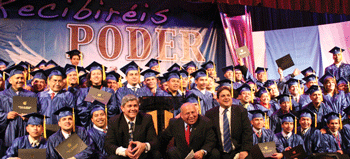 |
Ricardo Norton (front row, with fingers pressed together) is director of the Institute of Hispanic Ministry at Andrews University. Students in his program hail from the Caribbean nations, South and Central America, and Spain.
|
Hugo Magallanes, director of the Center for the Study of Latino/a Christianity and Religions at Perkins School of Theology in Dallas, notes that pastors of Hispanic churches must negotiate a number of cultural differences. Their congregations often include first-, second-, and third-generation Hispanics (and beyond), and each generation has its own set of concerns and needs. Ricardo Norton, who directs the Institute of Hispanic Ministry at Andrews University in Berrien Springs, Michigan, notes that although Seventh-day Adventist Hispanics are united in fundamental theological beliefs, there are differences in behavioral norms among people from various countries — including what to eat and drink, how to dress, and what kind of music to use — and all of these can affect the way a pastor relates to the community. Students in his program come from the Caribbean nations, South and Central America, and Spain.
“The way you minister in a predominantly Mexican community may be very different from the way you minister in a community that is predominantly Puerto Rican, or Cuban, or Nicaraguan,” says Father Presmanes. “While Hispanic is a name we use to describe this group of people, one has to understand that within that category are many subcategories. You minister in those communities from the prism of their reality.”
Princeton’s Tañón-Santos notes that an often neglected aspect of Hispanic ministry in the United States is the large population of people of Brazilian descent. Brazil is the most populous country in Latin America, but its emigrants to North America often worship at Spanish-speaking churches because there are no Portuguese-speaking congregations nearby. “The Latino church in America has had the challenge of our Portuguese-speaking brethren,” says Tañón-Santos. “They are an important part of the story.”
What kinds of programs are being offered?
-
Perkins School of Theology, Southern Methodist University, Dallas, Texas. North American schools have a variety of approaches to theological education in a Hispanic context. For example, the Center for the Study of Latino/a Christianity and Religions at Perkins, funded by a grant from the Luce Foundation, facilitates research in the area of Latino Christianity and religions and works in partnership with degree programs at Perkins.
All graduate programs at Perkins are in English, including programs at the Latino/a Center. However, the school has many bilingual faculty members who are able to converse with students in either language, and they often recommend books and materials in both languages. Many students minister in Spanish-speaking congregations while earning their master of divinity degrees.

|
|
Fernando Cascante is director of the Justo L. González Center in Orlando, Florida. “The gift that the Latino/Hispanic church is giving to the Anglo-Saxon church is an opportunity to revisit the way that they do theological education,” he says.
|
Perkins was one of the founding members of the Hispanic Theological Initiative Consortium (see below). In addition, since 1974 Perkins has been the home of the Mexican American Program (MAP), which supports curriculum and activities at Perkins that prepare ministerial students for ministries with Latinos, including a student group called L@s Seminaristas and a certificate in Hispanic studies. MAP also provides short-term intensive training programs on the Perkins campus for local pastors through the Licensing School (Escuela de Licencia), which enables pastors who lack the academic credentials for enrollment in a traditional M.Div. program to pursue ordination in the United Methodist Church. These classes are all in Spanish.
-
Asbury Theological Seminary, Wilmore, Kentucky. Asbury Seminary addresses Hispanic theological education through its Latino/Latina Studies Program (LLSP) at its Orlando campus. The program, which began in 2001, was the result of conversations between then-president Maxie Dunnam and a local Hispanic pastor who asked him for help addressing the need for theological education among local Spanish-speaking ministers.
All classes in Asbury’s Latino studies program are in Spanish and meet evenings or weekends, which accommodates the schedules of working students. LLSP offers both a certificate program and a program in which students complete 90 hours of work and then transfer to the Facultad Latinoamericana de Estudios Teológicos, a distance education program affiliated with Laurel University, to earn a B.A.
“I’ve seen students with a burning desire to learn more, students who have had no opportunity before this,” says Lizette Acosta, director of LLSP. “They begin to understand how much broader theology is than what they had thought. They experience these ‘aha’ moments in class, and I see lives literally being changed as their relationship with God is deepened.”
A typical LLSP student is already in ministry; some are senior pastors. Acosta notes that many students are seeking classes on pastoral counseling. “Partly this is because the Hispanic Christian community just recently awakened to the need for counseling. There has been some suspicion concerning this area of study in the past, but within the last ten years it seems that everyone has become aware of how beneficial it is.”
-
Barry University, Miami Shores, Florida. “We do theological and ministerial formation for both Roman Catholic and Protestant ministers who wish to work in the Hispanic Latino community,” says Father Presmanes of the Institute for Hispanic-Latino Theology and Ministry at Barry University. Students in both the master’s program in practical theology and the doctor of ministry program can specialize in Hispanic ministry using the curriculum provided by the institute.
A little more than half the Barry students are Catholic lay people involved in everything from pastoral work to religious education. Most of the Protestant students are ordained clergy in the doctor of ministry program. “Currently we have Lutherans, Episcopalians, Pentecostals — a wide range of denominations,” says Presmanes.
He notes that all classes are in English. “It really isn’t primarily about language. Most U.S. Hispanic theology is done in English. The difference is not language, but rather theology from the context of a specific community.”
-
Wesley Seminary at Indiana Wesleyan University, Marion, Indiana. One of the newest programs in Hispanic theological studies is the master of divinity program at Indiana Wesleyan University. In August 2011, Joanne Solis-Walker launched the first pilot class. The program is online, in Spanish, and includes faculty and students from the mainland United States, Puerto Rico, and Panama.
The curriculum is developed by teams of scholars, theologians, faculty, and laity, and all courses are teamtaught. “This is actually one of our biggest challenges,” says Solis-Walker, “to find faculty who are good team players. Our focus is on enabling faculty to be facilitators, which is a bit different from the traditional model.”
Although the program is mostly online, students must do two weeks of residency. “One of my biggest joys is to see our students and faculty come together for the residency part of the program. They consider each other friends — and brothers and sisters in Christ — long before they meet face to face, and those two weeks deepen the bonds that have been forged online,” says Solis- Walker. “You see friendships among pastors in different countries and states.”
“Online classes are also exciting because we have students in Panama, Colombia, Puerto Rico — we have all of Latin America as a potential pool of students.”
-
St. John’s Seminary, Camarillo, California. At St. John’s, every student is expected to graduate with the ability to minister in two “pastorally useful languages,” says Msgr. Craig Cox, the seminary’s rector. “For most of them, that’s English and Spanish, but for others, it’s English and Vietnamese, Korean, or sign language.”
Spanish isn’t required as long as a student can minister in two other languages. “But in reality,” Msgr. Cox says, “virtually all our Vietnamese and Korean students leave here with three languages — English and Spanish, in addition to the language of their country of origin.”
At St. John’s students from Asia, North America, and Latin America all learn one another’s customs. “We celebrate the lunar new year and feast days of the martyrs and saints from Vietnam, Korea, and Latin America,” he says. “We certainly celebrate the feast of Our Lady of Guadalupe, including an early morning procession. It’s not just learning the language, but also gaining insight into the genius of different ethnic backgrounds — how the faith is lived out in other communities.”
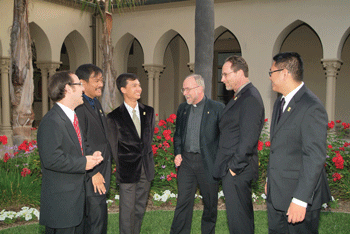
|
|
“Diversifying the faculty is a slower process than diversifying the student body, but it is an important part of our strategic plan,” says Msgr. Craig Cox (center), rector of St. John’s Seminary in California. Here he is flanked by seminarians (from left) Steven Marshall, Justin Ordoveza, Dac Ha, Ron Clark, and Ramont Medina.
|
An important part of the work of inclusion is faculty recruitment. “We very deliberately tried to find people of differing ethnic backgrounds for our faculty,” Cox says. “Diversifying the faculty is a slower process than diversifying the student body, but it is an important part of our strategic plan.” Are there ever any tensions? “It’s easy in a community with this much diversity to have misunderstandings and conflicts,” he says. “We actually see that as a blessing, because our students will be out in parishes where there will be multiple ethnic groups, and if they’ve experienced how difficult it can be to understand across cultural lines, they can be a lot more sensitive in their parish leadership.”
-
Andrews University, Berrien Springs, Michigan. Ricardo Norton pastored Hispanic churches in the Los Angeles area for 22 years before becoming director of the Institute of Hispanic Ministry at Andrews University in Berrien Springs, Michigan, where he directs a master’s degree program in pastoral ministry and a doctor of ministry program, both in Spanish. In addition, Norton founded a lay certificate school, Seminario Adventista Laico, to instruct church members in the theory and practice of ministry.
-
Princeton Theological Seminary, Princeton, New Jersey. The Hispanic/Latino(a) Leadership Program at Princeton Theological Seminary was begun more than 20 years ago by clergy from Presbyterian, Christian Reformed, and Reformed Church in America backgrounds to train lay people. “Eventually this morphed into a larger lay training program, but it also included tracks for pastoral renewal and formation,” says Amaury Tañón-Santos. Programs are mainly in Spanish and Portuguese.
What do boards need to know?
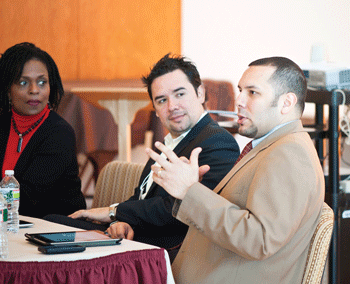 |
|
“Anyone who wants to do Hispanic ministry needs to understand that Hispanic ministry is itself multicultural and multireligious,” says Amaury Tañón-Santos of Princeton Theological Seminary (in foreground). A church he formerly led in New Jersey had only 70 to 80 people in attendance each week, but they represented 14 nationalities and eight denominations.
|
“Seminaries, particularly seminaries with large student bodies with diverse denominational backgrounds that are actively serving urban communities, should include courses that address the needs of the Hispanic community,” says Tañón-Santos. He believes that theological schools should look beyond the people and communities that they are already serving. “I was like many pastors when I served a congregation. I tried to identify people who were like us, and reach out to them, even if they were 20 to 25 miles away. Yet at the same time, there was an untouched resource right in our neighborhood — people who were seeking a Christian witness but were culturally different.”
Courses that deal with Hispanic issues are needed for both Hispanic and non-Hispanic students, says Tañón- Santos. “We should be more intentional in providing training on racial/ethnic thought, ministry, and culture in the church. We could be doing better.” He notes that the place for change is in core programs. If seminaries do not require exposure to Hispanic issues in these programs, students can ignore an increasingly important aspect of the church they will serve. “It’s not enough to have a lecture every year or a conference now and then.”
Fernando Cascante of AETH believes that faculty can be the greatest resource for change, but also the greatest obstacle to change. “I have seen lack of self-criticism about what we do in theological education,” he says. “And unless a school and its faculty understand the importance of the Hispanic community to the church and to society, they will never commit the time and resources needed for effective change.”
Father Presmanes of Barry University says that prioritizing Hispanic ministry must happen at the board level. “If your school has at the heart of its mission the proclamation of the gospel and the building up of the faith community, you can’t be blinded to the fact that you’ve got 50 million Christians who are underserved.”
Gifts to the church
Experts in Hispanic theology say that Latin American Christians can make significant contributions to North American theological reflection. “The gift that the Latino/Hispanic church is giving to the Anglo-Saxon church is an opportunity to revisit the way that they do theological education,” says Cascante. He suggests that with a strong emphasis on spiritual practices in everyday life, Latino theology can help bridge a divide between theory and practice that can exist within academic theology and at the congregational level.
Father Presmanes notes that Hispanic theology is “community-based theological reflection” and that the Hispanic community offers an alternate way to view ministry and spirituality — “ways which are much more communal, more celebratory than the traditional way of many Anglo churches.” He adds, “I think there is also a prophetic dimension, because the Hispanic community is more aware of the bad things going on in this world. They are attuned to the prophetic dimension of the gospel.”
Msgr. Cox says that Latino Catholics often emphasize family life, devotional life, and celebration, and that these enrich the entire community. But he notes that the experience of marginalization also has something to contribute to the larger American church. “So many of our immigrant people have not been at the center of wealth and power,” he says. “These are gifts that my Hispanic brothers and sisters bring. They remind us that Jesus worked very hard with people on the margins, and that there, on the margins, Jesus found people most open to God’s word.”
But if Latin Christians have experience on the margins of North American society, the place of Christianity in Latin America itself is both central and ancient. Tañón-Santos points out that Christianity has been established in Latin American for centuries. “People from Latin America bring a vast history of Christian teaching and expression and life,” he says. “There are more than 500 years of Christian history behind the church in Latin America, and I would argue that this informs all Christian traditions in Latin America, whatever the denomination.
“Even though there has been a strong Protestant presence in this area of the world for the last 100 to 125 years, the Roman Catholic background — the great things about it and the difficult things — still informs how we do church and do community.”
In addition, says Tañón-Santos, Latin Christians want to bring their Christian history and culture with them to North America, and to do so in partnership with North American Christians. And that, he says, is a great gift.
Which is it? Hispanic or Latino/a?
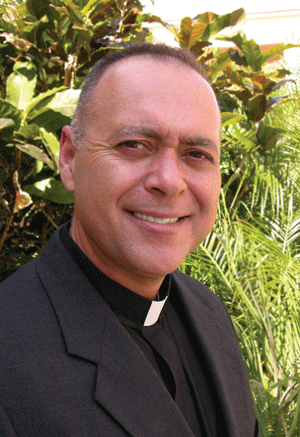 |
|
“McDonald’s and Burger King know the importance of paying attention to this market. But in religion, it’s an afterthought.”
— Father Jorge Presmanes
|
“That’s a great question,” says Father Jorge Presmanes, director of the Institute of Hispanic/Latino Theology at Barry University. “Most Latinos and Latinas self-identify with a reference to their ancestral country. For example, I self-identify as Cuban American.
“But as the communities from the many countries of Latin America have come together in the United States, we’ve embraced the terms Hispanic or Latino/a. Hispanic is most often used in the Northeast and in official Catholic documents. On the West Coast and in academic circles, the term that is most often used is Latino.”
Joanne Solis-Walker of Indiana Wesleyan University agrees. “In the East, people consider themselves Hispanic; in the West, Latinos. Another interesting dynamic is that Mexicans think of themselves as Latino and everyone else as Hispanic. I think that at some point we will get a mutual definition, but for now the term used depends on who the person is and where they are located.” She adds, “You sometimes see Latino/a written as Latin@, as a kind of shorthand.”
According to the 2011 National Survey of Latinos, conducted for the Pew Hispanic Center by Social Science Research Solutions, a majority of Hispanic adults prefer to identify themselves by their family’s country of origin. Almost 70 percent of survey respondents said that Latin Americans in the United States have many different cultures rather than a common culture.
When asked whether they preferred the term Hispanic or Latino, the same survey found that 51 percent said they didn’t care, while 33 percent favored Hispanic and 14 percent favored Latino. See www.bit.ly/NEu25a.
Statistics Canada, the census agency in Ottawa, uses the term Latin American, while the U.S. Census Bureau uses Hispanic or Latino or just Hispanic.
The Hispanic Theological Initiative Consortium (HTIC) Princeton, New Jersey
The Hispanic Theological Initiative (HTI) was established in 1996 to train individuals to support the growing Latino religious communities across the U.S. In 2007, the initiative expanded to become the Hispanic Theological Initiative Consortium (HTIC), an association of Ph.D.-granting institutions committed to expanding the number of Latino scholars. Students who are admitted to doctoral studies at one of the 20 member schools may receive support from HTIC. To date, HTI and HTIC have supported more than 40 master’s students and more than 70 Ph.D. students in theological and religious education.
For more information: www.ptsem.edu/hti/
La Asociación para la Educación Teológica Hispana (AETH) Aurora, Colorado
La Asociación para la Educación Teológica Hispana (AETH) was founded in 1991 to support theological education for Hispanic pastors and church leaders in Bible institutes, seminaries, and other programs in the United States, Canada, and Puerto Rico. Recently, AETH created the Justo L. González Center as a centralized resource center for Hispanic/Latino ministries, addressing the need for accessible and affordable Latino-focused and Latino-relevant theological resources.
In 2010, Stan Perea, executive director of AETH, and Daniel O. Aleshire, executive director of the Association of Theological Schools (ATS), began conversations about the future of theological education for Hispanic church leaders. Both were aware that Latinos preparing for ministry often lack the bachelor’s degrees normally required for admission to ATS schools, and, as a result, many attend Bible institutes rather than accredited seminaries.
With funding from the Henry Luce Foundation, a joint ATS–AETH commission is developing certification standards for Bible institutes that will smooth the pathway for institute graduates to continue their education in ATS accredited schools.
Perea and Aleshire hope that a final version of the standards will be approved by both their organizations by the end of 2012, with implementation to begin in 2013.
More information: www.aeth.org.
Center for the Study of Latino Religion (CSLR) Notre Dame, Indiana
The Center for the Study of Latino Religion (CSLR) at the University of Notre Dame publishes research about the impact of religion and spirituality on the development of social capital in the Latino community. Edwin Hernández, founding director of the center and current research fellow, is the coauthor of Reconstructing the Sacred Tower: Challenge and Promise of Latino/a Theological Education (University of Scranton Press, 2005) and Emerging Voices, Urgent Choices: Essays on Latino/a Religious Leadership (Brill, 2006). Hernández is a member of the board of directors of In Trust.
Many publications are available free of charge from the center’s website at latinostudies.nd.edu/library-archives/publications-archive/, including a six-part study by Hernández and his research team:
-
“A Demographic Profile of Latino/a Seminarians”
-
“An Educational and Ministerial Profile of Latino/a Seminarians”
-
“Latino/a Seminarians’ Vocational Motivations and Views about the Church’s Role in Society”
-
“Finding the Right Seminary: Influences on Institutional Choice, Expectations, and Satisfaction among Latino/a Seminarians”
-
“Latino/a Seminarians’ Evaluations of Their Institutions’ Quality and Commitment”
-
“What Can Seminaries Do to Prepare Their Students for Ministry in the Latino Community?”
Do you know of other schools that offer programs for Hispanic students who are preparing for ministry? Let us know at editors@intrust.org.